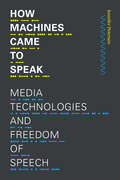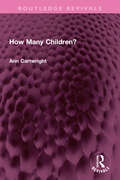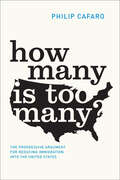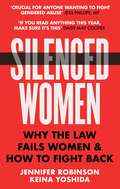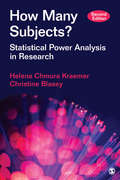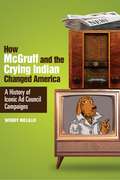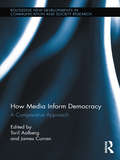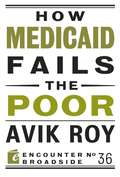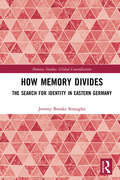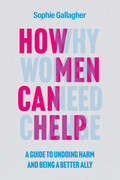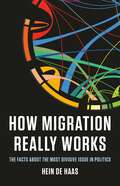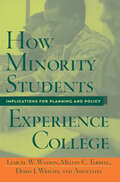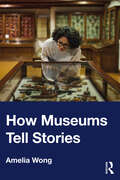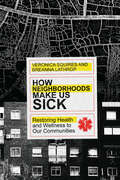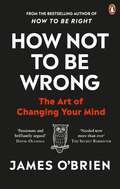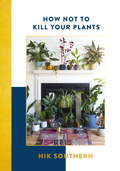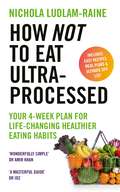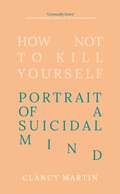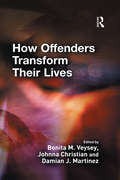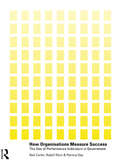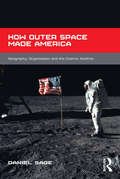- Table View
- List View
How Machines Came to Speak: Media Technologies and Freedom of Speech (Sign, Storage, Transmission)
by Jennifer PetersenIn How Machines Came to Speak Jennifer Petersen constructs a genealogy of how legal conceptions of “speech” have transformed over the last century in response to new media technologies. Drawing on media and legal history, Petersen shows that the legal category of speech has varied considerably, evolving from a narrow category of oratory and print publication to a broad, abstract conception encompassing expressive nonverbal actions, algorithms, and data. She examines a series of pivotal US court cases in which new media technologies—such as phonographs, radio, film, and computer code—were integral to this shift. In judicial decisions ranging from the determination that silent films were not a form of speech to the expansion of speech rights to include algorithmic outputs, courts understood speech as mediated through technology. Speech thus became disarticulated from individual speakers. By outlining how legal definitions of speech are indelibly dependent on technology, Petersen demonstrates that future innovations such as artificial intelligence will continue to restructure speech law in ways that threaten to protect corporate and institutional forms of speech over the rights and interests of citizens.
How Many Children? (Routledge Revivals)
by Ann CartwrightAnn Cartwright’s book Parents and Family Planning Services (1970) had become a classic in its field.Originally published in 1976, How Many Children? Dr Cartwright’s study of family size and spacing in England and Wales in 1973 is again based on detailed research and analysis, and upon interviews with the mothers and fathers of a random sample of legitimate births in England and Wales.Ann Cartwright discusses the extent to which people have firm intentions about their family structure and the factors which may affect these intentions – work, housing, economic situation, marital relationships and family roles. She describes the part played by contraception, abortion and birth control services in people’s achievement of their intentions.A major interest of the study is in changes over time. It attempts to throw some light on the falling birth rate and the relative contributions to this decline of desires for smaller families, different spacing patterns and the use of more effective methods of birth control. Comparisons are made with the earlier study, Parents and Family Planning Services, and a fascinating conundrum emerges: in the later study, parents were using more effective methods of birth control but the proportion of unintended pregnancies had not declined. Possible explanations for this are discussed.
How Many Is Too Many?: The Progressive Argument for Reducing Immigration into the United States (Chicago Studies in American Politics)
by Philip CafaroFrom the stony streets of Boston to the rail lines of California, from General Relativity to Google, one of the surest truths of our history is the fact that America has been built by immigrants. The phrase itself has become a steadfast campaign line, a motto of optimism and good will, and indeed it is the rallying cry for progressives today who fight against tightening our borders. This is all well and good, Philip Cafaro thinks, for the America of the past--teeming with resources, opportunities, and wide open spaces--but America isn’t as young as it used to be, and the fact of the matter is we can’t afford to take in millions of people anymore. We’ve all heard this argument before, and one might think Cafaro is toeing the conservative line, but here’s the thing: he’s not conservative, not by a long shot. He’s as progressive as they come, and it’s progressives at whom he aims with this book’s startling message: massive immigration simply isn’t consistent with progressive ideals. Cafaro roots his argument in human rights, equality, economic security, and environmental sustainability--hallmark progressive values. He shows us the undeniable realities of mass migration to which we have turned a blind eye: how flooded labor markets in sectors such as meatpacking and construction have driven down workers’ wages and driven up inequality; how excessive immigration has fostered unsafe working conditions and political disempowerment; how it has stalled our economic maturity by keeping us ever-focused on increasing consumption and growth; and how it has caused our cities and suburbs to sprawl far and wide, destroying natural habitats, driving other species from the landscape, and cutting us off from nature. In response to these hard-hitting truths, Cafaro lays out a comprehensive plan for immigration reform that is squarely in line with progressive political goals. He suggests that we shift enforcement efforts away from border control and toward the employers who knowingly hire illegal workers. He proposes aid and foreign policies that will help people create better lives where they are. And indeed he supports amnesty for those who have, at tremendous risk, already built their lives here. Above all, Cafaro attacks our obsession with endless material growth, offering in its place a mature vision of America, not brimming but balanced, where all the different people who constitute this great nation of immigrants can live sustainably and well, sheltered by a prudence currently in short supply in American politics.
How Many More Women?: The silencing of women by the law and how to stop it
by Jennifer Robinson Keina Yoshida'Compelling... brilliant but shaming.' CHERIE BLAIR, KC'Crucial reading for any person wanting to fight against all forms of gendered abuse.' JESS PHILLIPS, MP'This book is another brick through the windows of our legal systems: a brilliant, trenchant analysis of what is wrong with the law.' HELENA KENNEDY, KC We are in a crucial moment: women are breaking through the cultural reticence around gender-based violence. But just as survivors have begun to feel empowered to speak out, a new form of systematic silencing has made itself more evident: rich and powerful men are using teams of lawyers to suppress allegations and prevent newspaper stories from running. Individual women, advocacy groups and journalists find themselves fighting against censorship. The law is being wielded to reinforce the status quo of silence that existed before #MeToo.If women cannot speak about their abuse - and journalists are fearful of telling their stories - then how can we understand the problem of gender-based violence in our society? And how can we even begin to end it?In How Many More Women? internationally-acclaimed human rights lawyers, Jennifer Robinson and Keina Yoshida, examine the broken systems and explore the changes needed in order to ensure that women's freedom, including their freedom of speech, is no longer threatened by the laws that are supposed to protect them.
How Many Subjects?: Statistical Power Analysis in Research
by Helena Chmura Kraemer Christine M. BlaseyWith increased emphasis on helping readers understand the context in which power calculations are done, this Second Edition of How Many Subjects? by Helena Chmura Kraemer and Christine Blasey introduces a simple technique of statistical power analysis that allows researchers to compute approximate sample sizes and power for a wide range of research designs. Because the same technique is used with only slight modifications for different statistical tests, researchers can then easily compare the sample sizes required by different designs and tests to make cost-effective decisions in planning a study. These comparisons demonstrate important principles of design, measurement, and analysis that are rarely discussed in courses or textbooks, making this book a valuable instructional resource as well as a must-have guide for frequent reference.
How Materials Matter: Design, Innovation and Materiality in the Pacific
by Graeme WereHow does design and innovation shape people’s lives in the Pacific? Focusing on plant materials from the region, How Materials Matter reveals ways in which a variety of people – from craftswomen and scientists to architects and politicians – work with materials to transform worlds. Recognizing the fragile and ephemeral nature of plant fibres, this work delves into how the biophysical properties of certain leaves and their aesthetic appearance are utilized to communicate information and manage different forms of relations. It breaks new ground by situating plant materials at the centre of innovation in a region.
How Materials Matter: Design, Innovation and Materiality in the Pacific
by Graeme WereHow does design and innovation shape people’s lives in the Pacific? Focusing on plant materials from the region, How Materials Matter reveals ways in which a variety of people – from craftswomen and scientists to architects and politicians – work with materials to transform worlds. Recognizing the fragile and ephemeral nature of plant fibres, this work delves into how the biophysical properties of certain leaves and their aesthetic appearance are utilized to communicate information and manage different forms of relations. It breaks new ground by situating plant materials at the centre of innovation in a region.
How May I Help You?: An Immigrant's Journey from MBA to Minimum Wage
by Deepak SinghIn this moving and insightful work, Deepak Singh chronicles his downward mobility as an immigrant to a small town in Virginia. Armed with an MBA from India, Singh can get only a minimum-wage job in an electronics store. Every day he confronts unfamiliar American mores, from strange idioms to deeply entrenched racism. Telling stories through the unique lens of an initially credulous outsider who is “fresh off the plane,” Singh learns about the struggles of his colleagues: Ron, a middle-aged African-American man trying to keep his life intact despite health concerns; Jackie, a young African-American woman diligently attending school after work; and Cindy, whose matter-of-fact attitude helps Deepak adapt to his job and his new life. How May I Help You? is an incisive take on life in the United States and a reminder that the stories of low-wage employees can bring candor and humanity to debates about work, race, and immigration.
How McGruff and the Crying Indian Changed America: A History of Iconic Ad Council Campaigns
by Wendy MelilloHow McGruff and the Crying Indian Changed America: A History of Iconic Ad Council Campaigns details how public service advertising campaigns became part of our national conversation and changed us as a society. The Ad Council began during World War II as a propaganda arm of President Roosevelt's administration to preserve its business interests. Happily for the ad industry, it was a double play: the government got top-notch work; the industry got an insider relationship that proved useful when warding off regulation. From Rosie the Riveter to Smokey Bear to McGruff the Crime Dog, How McGruff and the Crying Indian Changed America explores the issues and campaigns that have been paramount to the nation's collective memory and looks at challenges facing public service campaigns in the current media environment.
How Media Inform Democracy: A Comparative Approach (Routledge New Developments in Communication and Society Research)
by James Curran Toril AalbergIn this timely book, leading researchers consider how media inform democracy in six countries – the United States, the United Kingdom, Belgium, the Netherlands, Norway, and Sweden. Taking as their starting point the idea that citizens need to be briefed adequately with a full and intelligent coverage of public affairs so that they can make responsible, informed choices rather than act out of ignorance and misinformation, contributors use a comparative approach to examine the way in which the shifting media landscape is affecting and informing the democratic process across the globe. In particular, they ask: Can a comparative approach provide us with new answers to the question of how media inform democracy? Has increased commercialization made media systems more similar and affected equally the character of news and public knowledge throughout the USA and Europe? Is soft news and misinformation predominantly related to an American exceptionalism, based on the market domination of its media and marginalized public broadcaster? This study combines a content analysis of press and television news with representative surveys in six nations. It makes an indispensable contribution to debates about media and democracy, and about changes in media systems. It is especially useful for media theory, comparative media, and political communication courses.
How Medicaid Fails the Poor
by Avik RoyMedicaid, America's government-run health insurance program for the poor, should be a lifeline that provides needed health care to Americans with no other options. Surprisingly, however, it doesn't. The medical literature reveals a $450 billion-a-year scandal: that people on Medicaid have far worse health outcomes than those with private insurance, and no better outcomes than those with no insurance at all.Why is this so? In How Medicaid Fails the Poor, Avik Roy explains how Medicaid's clumsy design and perverse incentives make it hard for people on Medicaid to get the medical care they need. Medicaid doesn't reimburse doctors or hospitals for the cost of caring for Medicaid enrollees, forcing many doctors to opt out of the program.The Affordable Care Act, otherwise known as Obamacare, doubles down on this broken system. Roy shows us that there are better ways, using private insurance, to provide needed care to our poorest citizens.
How Memory Divides: The Search for Identity in Eastern Germany (Memory Studies: Global Constellations)
by Jeremy Brooke StraughnThis book examines the paradox of collective identity in eastern Germany in the wake of German reunification. Following the fall of the Berlin Wall, citizens of the former German Democratic Republic were confronted with a dilemma: Were they already Germans without qualification, like their compatriots in the West? Or did they remain "East Germans" for the time being, with an identity tied to their distinct past, as if they were foreigners who had migrated without leaving home? How Memory Divides shows that these questions remain unresolved even today, less because of any "incomplete unity" between Germans in West and East, than because of the contradictory ways in which "easterners" themselves have remembered their past. Drawing on a unique study spanning two decades, the author reveals how divergent biographical memories have given rise to life stories with a diverse array of genres and storylines at odds with official accounts of the GDR and its demise. Over time, efforts to effect unity between West and East have reproduced divisions within the East. This book will appeal to scholars and students of sociology and politics with interests in memory, heritage, and identity.
How Men Can Help: A Guide to Undoing Harm and Being a Better Ally
by Sophie Gallagher'Sobering, thought-provoking and action-provoking ... I can't recommend it highly enough' Nihal Arthanayake, BBC Radio Five Live'Thoughtful, empowering and important' Mishal HusainHave you ever...seen a report on the news about male violence,heard a troubling story from a female friend,or witnessed a woman being treated unfairly...and wondered what men can do about it?In this accessible and inclusive new book, award-winning journalist and campaigner Sophie Gallagher brings men into the conversation and explores how they can help change our society for the better.Looking at everything from the #NotAllMen argument to challenging assumptions about women, and from learning about The Gap to how to act when passing a woman in the street at night, Sophie reveals the biggest issues standing in the way of gender equality and offers practical steps and advice on how to be part of the solution, not the problem.How Men Can Help is an essential book for anyone looking to understand the past, improve their behaviour in the present, and make a brighter, safer and fairer future for everyone.
How Migration Really Works: The Facts About the Most Divisive Issue in Politics
by Hein de HaasAn authoritative guide to global migration that corrects decades of misunderstanding and misguided policy, "defying orthodoxy on all sides of the debate" (Yascha Mounk, author of The Identity Trap). As debates on immigration have reached fever pitch, so has political and media fearmongering. But what are the facts behind the headlines? Drawing on three decades of research, migration expert Hein de Haas destroys the myths that politicians, interest groups, and media spread about immigration. He reveals: Global migration is not at an all-time high Climate change will not lead to mass migration Immigration mainly benefits the wealthy, not workers Border restrictions have paradoxically produced more migration Ultimately, de Haas shows migration not as a problem to be solved, nor as a solution to a problem, but as it really is. This book is an essential guide to one of our most divisive political issues, showing how we can move beyond today&’s deeply polarized debate and make migration work better for everyone.
How Minority Students Experience College: Implications for Planning and Policy
by Michael J. Cuyjet Fred A. Bonner II Melvin Cleveland Terrell Lemuel Watson Doris J. Wright"I feel like they act like they're so diverse and multicultural.This is not a representation of how it is for people who go here.""I know of several occasions, if it weren't for several faculty of color, I don't know how I would have made it from one day to the next." -- from student interviewsHave three decades of integration and multicultural initiatives in higher education delivered a better education to all students? Are majority and minority students reaping similar benefits, specifically in predominantly white colleges? Do we know what a multicultural campus should look like, and how to design one that is welcoming to all students and promotes a learning environment?Through a unique qualitative study involving seven colleges and universities considered national models of commitment to diversity, this book presents the views and voices of minority students on what has been achieved and what remains to be done. The direct quotations that form the core of this book give voice to Black, Hispanic, Asian, Native American and bi-racial students. They offer in their own words their perceptions of their campus cultures and practices, the tensions they encounter and what works for them.Rather than elaborating or recommending specific models or solutions, this book aims to provide insights that will enable the reader better to understand and articulate the issues that need to be addressed to achieve a well-adapted multicultural campus.Presidents, academic affairs professionals, student affairs personnel and faculty concerned with equity and diversity will find this book helpful and enlightening.
How Museums Tell Stories
by Amelia WongHow Museums Tell Stories explains how museums “work” as a form of media that narrates stories intentionally and unintentionally. Story—in life and in museums—is a phenomenon that emerges as people perceive, represent, and interpret the qualities of tellability and narrativity in relation to stimuli. Tellability is noteworthiness: it attracts our attention. Narrativity is a set of elements that enables us to perceive a story is being or could be told. The book discusses how and why these qualities are so present in museums, and how they enable physical institutions to tell stories in many forms, at many scales, in many styles of representation, and to varying degrees. Drawing on conceptions of narrative from literary theory, film, psychology, and cognitive science, Wong offers a shared vocabulary for understanding and analyzing how story manifests in museums at the level of objects, collections, exhibitions, and space.How Museums Tell Stories will be essential reading for researchers and students interested in how and why museums engage audiences, as well as museum and cultural heritage practitioners seeking concepts and analytical tools for approaching and evaluating their work more critically and conscientiously.
How My Family Lives In America
by Susan KuklinIn How My Family Lives in America, author-photographer Susan Kuklin zeroes in on the source of cultural identity: the family. <p><p> Meet: <p> Sanu, who is learning how to braid her hair and to cook the same African meal her father makes. <p> Eric, who loves to play baseball with his dad and to dance the merengue with his friends and family. <p> April, who works hard on her Chinese writing and tries to keep up with her family's challenging games. <p> Their stories emphasize the seemingly minor and everyday ways heritage is transmitted: stories, songs, games, language, special occasions. They show the importance of choice and adaptation in forging a cultural identity. And they provoke readers to examine their own families -- what makes them the same, what makes them distinct, and how this uniqueness is celebrated.
How Neighborhoods Make Us Sick: Restoring Health and Wellness to Our Communities
by Veronica Squires Breanna LathropOur neighborhoods are literally making us sick. Buildings with mold trigger asthma and other respiratory conditions. Geographic lack of access to food and health care increases childhood mortality. Community violence traumatizes residents. Poverty, unemployment, inadequate housing, food insecurity, racial injustice, and oppression cause physical changes in the body, resulting in disease and death. But there is hope. Loving our neighbor includes creating social environments in which people can be healthy. While working in community redevelopment and treating uninsured families, Veronica Squires and Breanna Lathrop discovered that creating healthier neighborhoods requires a commitment to health equity. Jesus' ministry brought healing through dismantling systems of oppression and overturning social norms that prevented people from living healthy lives. We can do the same in our communities through addressing social determinants that facilitate healing in under-resourced neighborhoods. Everyone deserves the opportunity for good health. The decisions we make and actions we take can promote the health of our neighbors.
How Not To Be Wrong: The Art of Changing Your Mind
by James O'Brien'Simply Brilliant' THE SECRET BARRISTER'Passionate and brilliantly argued' DAVID OLUSOGA'An admirably personal guide' MARINA HYDE'Smart, analytical, self-aware and important' ALASTAIR CAMPBELLTHE INTIMATE, REVEALING NEW BOOK FROM THE AUTHOR OF THE BESTSELLING, PRIZE-WINNING HOW TO BE RIGHT There's no point having a mind if you're not willing to change it James O'Brien has built well over a million loyal listeners to his radio show by dissecting the opinions of callers live on air, every day. But winning the argument doesn't necessarily mean you're right. In this deeply personal book, James turns the mirror on himself to reveal what he has changed his mind about and why, and explores how examining and changing our own views is our new civic duty in a world of outrage, disagreement and echo chambers. He writes candidly about the stiff upper lip attitudes and toxic masculinity that coloured his childhood, and the therapy and personal growth that have led him question his assumptions and explore new perspectives. Laying open his personal views on everything from racial prejudice to emotional vulnerability, from fat-shaming to tattoos, he then delves into the real reasons -- often irrational or unconscious -- he holds them. Unflinchingly honest, revealing and funny, How Not to Be Wrong is a tonic for a world more divided than ever and a personal manifesto for a better way of thinking and living. Because after all, if we can't change our own minds we'll never really be able to change anyone else's.
How Not To Kill Your Plants: Know, Grow And Style
by Nik SouthernHands up if you've killed a plant? Yep, me too. It's no secret that we've all become plant obsessed, but do we really understand how to look after them? I am not a Professor of Botany, but having run my florist and plant shop, Grace & Thorn, since 2011 I've learnt a few things along the way. HOW NOT TO KILL YOUR PLANTS is about taking the hocus-pocus out of plants and flowers and enabling you to understand a plant's needs in order to know where to place and how to style them, but most importantly how to keep them alive.I get asked every type of question you can imagine and I have written this book to answer them. Watering can down, it's time to go back to the roots.Keep it green.Nik x(AKA The Agony Plant)
How Not to Eat Ultra-Processed: Your 4-week plan for life-changing healthier eating habits
by Nichola Ludlam-RaineWe know we should eat fewer ultra-processed foods; this book shows you how to do it.From expert dietitian, Nichola Ludlam-Raine, comes this simple, easy-to-follow plan for reducing the ultra-processed foods in your diet.Taking you through 4 weeks, each focused on a different meal (snacks and drinks, breakfast, lunch and dinner), Nichola equips you with the practical ways you can make a huge difference to your diet through small, achievable changes.Along the way she also debunks the myths that surround ultra-processed foods and provides answers to the most commonly asked questions, to help soothe anxiety around what you eat and enable you to feel confident with what's on your plate, wherever you are and whatever time of the day.With recipes to get you started and a comprehensive list of over 100 processed and ultra-processed foods, ranked according to their nutritional benefits and with guidance on how often you should eat them, this is a necessary guide for anyone looking to eat healthier and make a real change to their long-term health.
How Not to Kill Yourself: Portrait of a Suicidal Mind
by Clancy MartinThe last time Clancy Martin tried to kill himself was in his basement with a dog leash. He didn&’t write a note. How Not to Kill Yourself is an affirmation of life by someone who has tried to end it multiple times. It&’s about standing in your bathroom every morning, gearing yourself up to die. It&’s about choosing to go on living anyway. In an unflinching account of his darkest moments, Clancy Martin makes the case against suicide, drawing on the work of philosophers from Seneca to Jean Améry. Through critical inquiry and practical steps, we might yet answer our existential despair more freely – and with a little more creativity.
How Offenders Transform Their Lives
by Bonita Veysey Johnna Christian Damian J. MartinezAt a time when the scale of imprisonment in the United States has reached a historic high, researchers estimate that more than 600,000 individuals a year are released from prison to return to their home communities. These individuals have serious needs, such as finding employment and housing, reuniting with family members, and obtaining healthcare and treatment for alcohol and substance abuse problems. While research in this area has stressed these aspects of the transition from prison, a less explored area of research considers the role of internal identity shifts from that of an offender to one of citizen, and how this creates the conditions for desistance from criminal behavior both within the confines of a correctional facility and in the reentry process. This book presents a series of studies (mostly qualitative) that investigate individual identity transformation from offender status to pro-social, non-offending roles. Moreover, the work in this volume highlights the perspectives of the men and women who are current or formerly incarcerated people. Each piece provides an empirical analysis of the interaction between current or former prisoners and innovative pro-social programs and networks, which are grounded in the most current theoretical work about individual transformation and change. This book will be of interest to undergraduates, postgraduates, researchers and lecturers in all fields within the social sciences, but especially criminology and criminal justice and sociology and social work/welfare.
How Organisations Measure Success: The Use of Performance Indicators in Government
by Neil Carter Rudolf Klein Patricia DayThroughout the 1980s the British Civil Service devoted much time and energy developing indicators to measure the performance of government. Never before had so much stress been placed on accountability and performance; a trend which will be reinforced as government continues to devolve activities to agencies and looks for methods to assess their performance. How Organisations Measure Success analyses existing methods from their origins in the 1960s to their revival in the 1980s as part of the Financial Management Initiative and its apotheosis in the 1990s Next Steps Initiative. How Organisations Measure Success reports on two years of field research funded by the Economic and Social Research Council and will be of great interest to students of social policy and public administration as well as professionals working in government and public sector management.
How Outer Space Made America: Geography, Organization and the Cosmic Sublime
by Daniel SageIn this innovatory book Daniel Sage analyses how and why American space exploration reproduced and transformed American cultural and political imaginations by appealing to, and to an extent organizing, the transcendence of spatial and temporal frontiers. In so doing, he traces the development of a seductive, and powerful, yet complex and unstable American geographical imagination: the ’transcendental state’. Historical and indeed contemporary space exploration is, despite some recent notable exceptions, worthy of more attention across the social sciences and humanities. While largely engaging with the historical development of space exploration, it shows how contemporary cultural and social, and indeed geographical, research themes, including national identity, critical geopolitics, gender, technocracy, trauma and memory, can be informed by the study of space exploration.
